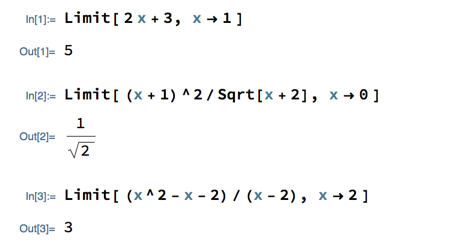Purpose
This problem set helps you become comfortable using algebra and limit laws to find limits. It also introduces you to how Mathematica can find limits automatically.
This problem set addresses the following learning outcomes:
- “Limits and Derivatives,” outcome number 1
- “Technology,” outcome number 7.
Background
This problem set draws on the “Evaluating Limits with the Limit Laws” and “Additional Limit Evaluation Techniques” subsections of section 2.3 in our textbook.
This problem set also asks you to find limits using Mathematica. I plan to demonstrate
how to do this in class on September 14, but if you want to try it sooner (or if I
don’t manage to do the demonstration), here is the main idea: Mathematica has a
Limit function that finds limits. Its arguments are the expression whose
limit you want to find, and the place at which you want that limit. For example, here
is Mathematica evaluating some simple limits:

Type the arrow indicating the place at which to find the limit by typing a hyphen (“-”) immediately followed by a greater-than sign (“>”) on your keyboard; Mathematica will replace those two characters with the arrow shown in the examples.
Notice that this example also shows how you can write square roots in Mathematica by
using the Sqrt function.
Activity
Solve the following problems:
Question 1
Use algebra and limit laws to find the following limits. Once you have found the limits by hand, use Mathematica to confirm your answers:
Limit 1
(Exercise 94 in section 2.3 of the textbook)
Limit 2
(Inspired by Exercise 98 in section 2.3 of the textbook)
Limit 3
(Exercise 102 from section 2.3 of the textbook)
Limit 4
(Exercise 100 in section 2.3 of the textbook)
Question 2
Consider the function
Part A
Give an example of a value
Part B
Give an example of a value
Follow-Up
I will grade this exercise during one of your weekly individual meetings with me. During this meeting I will look at your solution, ask you any questions I have about it, answer questions you have, etc. Sign up for the meeting via Google calendar. Please have a written solution to the exercise ready to share with me during your meeting, as that will speed the process along.